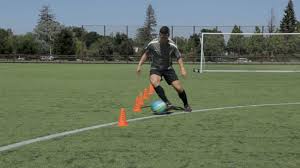In soccer, dribbling is more than just flair it’s a functional weapon. Whether it’s weaving through defenders, creating space under pressure, or drawing fouls in dangerous areas, top-tier dribbling separates elite players from the average. But behind the smooth stepovers and lightning-quick cuts are highly specific training routines often kept under wraps that transform good players into unstoppable attackers.
Here’s a look inside the secret drills, methods, and routines that sharpen dribbling technique at the highest levels of the game.
1. Ball Mastery Drills – The Foundation of All Great Dribblers
Elite dribblers start with daily ball mastery routines short, sharp drills that build total control. These exercises involve tight, repetitive touches that condition the feet to move fluidly with the ball.
Examples of ball mastery routines:
- Toe touches & sole rolls: Teach close control and foot feel
- L-drags, U-turns, and V-cuts: Develop directional change and awareness
- Inside-outside touches: Mimic real dribbling rhythm used in one-on-one situations
Players like Lionel Messi and Andrés Iniesta were known for spending hours working on simple ball touches, refining control with both feet. The goal isn’t speed it’s precision, rhythm, and comfort under pressure.
2. Cone Mazes and Obstacle Dribbles
While cone dribbling is common at all levels, elite versions involve chaotic, randomized layouts that mimic game-like situations. These drills force players to adapt quickly, keeping their heads up while maneuvering through tight spaces.
Why it works:
- Builds agility under control
- Encourages tight turns and sharp direction changes
- Promotes head-up dribbling essential for vision during the game
At pro academies, these drills are often paired with timed challenges or combined with visual stimuli (e.g. colored cones or lights) to trigger decision-making on the move.
3. Shadow Dribbling and Mirror Drills
One of the more secretive methods used by high-level coaches is shadow dribbling, where a player mimics the dribbling movements of a partner or a coach in real time without a ball.
This helps develop:
- Body coordination
- Muscle memory for common dribbling patterns
- Foot anticipation for feints and fakes
Advanced variations include “mirror” drills where two players face off, and one acts as the attacker while the other shadows teaching both attack and defensive reading.
4. Resistance and Speed Band Dribbling
Using resistance bands while dribbling helps players build explosiveness and improve balance during tight control. These drills are often used in private sessions with trainers and are rarely seen in public practices.
Benefits include:
- Enhanced core stability while changing direction
- Improved burst acceleration post-dribble
- Increased dribbling endurance
This method is used by players like Kylian Mbappé, who blend speed with control to devastating effect.
5. Small-Sided Games with Limited Touches
Small-sided games (3v3, 4v4) on reduced fields with limited touches force players to make quick decisions and sharp movements perfect for improving real-game dribbling.
Variations include:
- One-touch zones followed by free-touch zones
- “Keep-the-ball” rondos with pressure rules
- Man-marked dribble zones, where only one player is allowed to dribble
The constant pressure and tight space simulate match conditions, sharpening the instinct to protect the ball while staying creative.
6. Video Feedback and Slow-Motion Analysis
Top academies and personal coaches use video feedback to break down a player’s dribbling patterns frame-by-frame. This allows for:
- Technical analysis of foot placement and body positioning
- Identifying inefficient movements
- Reinforcing correct form using visual learning
Some use VR-based systems to simulate one-on-one dribble scenarios, which help players read defender movements and improve real-time decision-making.
7. Cognitive Dribbling Drills (Mind-Body Sync)
Modern dribbling training often includes cognitive overload drills, where players perform mental tasks while dribbling (like solving math problems or reacting to colored lights).
Why? Because soccer is a fast, reactive game. These drills improve:
- Split-second decision-making
- Peripheral vision
- Mental fatigue handling under physical stress
Elite programs like Ajax and Red Bull academies frequently incorporate this kind of training to elevate both dribbling and match intelligence.
Dribbling Is a Crafted Art
Behind every mesmerizing dribble is a science. Elite soccer players aren’t born with magical feet — they train them with intention, precision, and consistency. These secret routines go far beyond flashy skills; they focus on balance, agility, vision, and split-second decision-making.
Whether it’s a young talent trying to break into the first team or a seasoned pro sharpening their edge, one truth remains: great dribbling is never accidental it’s engineered through disciplined, intelligent training.

